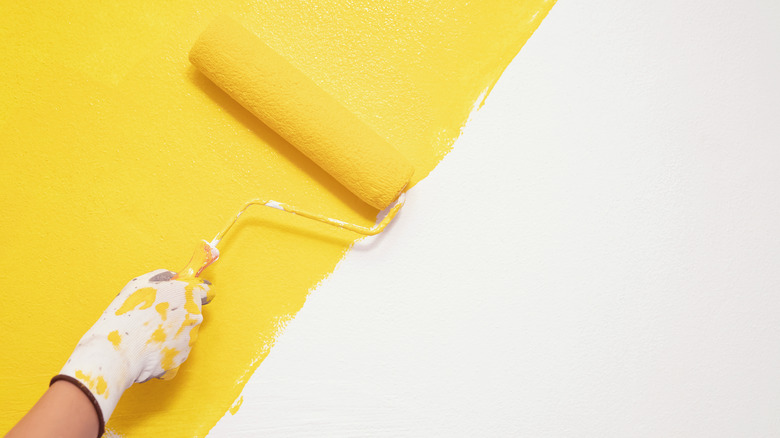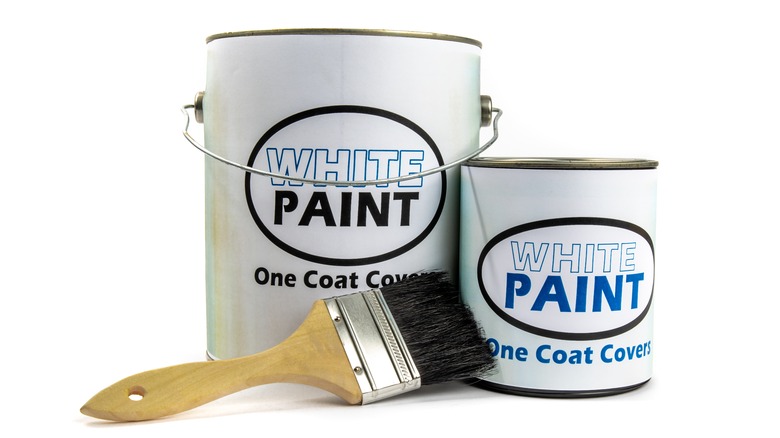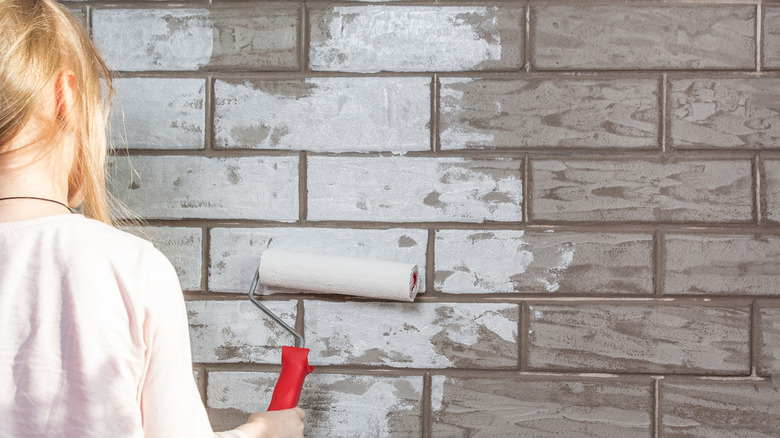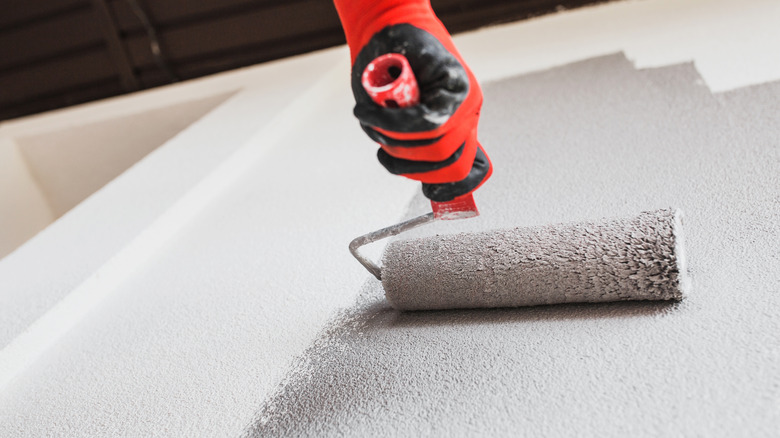Here's How Long It Really Takes For Paint To Dry
If you find yourself stuck watching paint dry it'll pay to know how long it actually takes. Among the main factors influencing drying, according to Arizona Painting Company, are the type of paint; how it is applied and the thickness of each coat; and environmental conditions such as humidity, temperature, and ventilation, which can have a negative impact. The painted surface and even the paint color can make a difference too. Whether paint is matte, semi-gloss, or glossy is another aspect to consider — a matte sheen dries the fastest.
Paint is considered dry when its liquids evaporate and the solids harden to the point where it is dry and no longer tacky when touched. To be fully set, paint needs time to cure so it can withstand normal wear and tear. Latex paint has a relatively quick drying time and oil-based options have the shortest curing period. A matter of hours is all that is required for latex or oil-based paints to dry; however, the duration of the curing time is another aspect. Oil paint may need as much as a week, but a latex paint may not be fully cured for a month under less-than-optimal conditions. Knowing the drying times, understanding the curing process, and waiting before applying additional coats can be the difference between a job you are proud of and a sub-par project that might have to be redone by a professional.
Drying (and curing) times for different paint types
Latex paint and oil-based paint have different drying times and the curing stage takes longer for one than the other. Westlake Interior Painting confirms that a coat of latex paint needs only between 1 and 3 hours to dry, and a second coat can be applied soon after. The lengthy curing time for the paint (which actually does not contain natural latex) is due to the fact that it dries from the outside in. Oil-based paints have a longer drying time (between 6 and 8 hours), and they require more time between layers, making it difficult to paint more than a single coat in a day. However, the attenuated curing period shortens the overall process, making oil-based paints ideally suited for floors and trim. Water-based paint dries quickly (3 hours should suffice), and primers should be allowed several hours too.
Per DIY Painting Tips, the drying time for paints is a function of the ratio of solvents and solids. Ingredients such as mineral spirits need to evaporate to allow oil paints to completely harden when exposed to oxygen, and thus totally dry. A paint containing less solvents will dry faster because it has fewer compounds that need to set. Paints are at their most vulnerable while curing, but once thoroughly dried they are able to withstand picture hanging and the returning of furniture, and also resist scratches, stains, and other blemishes. Once cured, painted surfaces are ready for mild washing.
Factors that determine drying
CertaPro Painters asserts that the best temperature for paint drying is around 70 degrees Fahrenheit, with an acceptable range of 50 to 90 degrees. For best results, relative humidity should remain in the 40 to 70% range. Moisture makes paint less able to dry and adhere to a surface, and water-based paint especially will dry faster in a room with adequate airflow. Depending on moisture and heat levels, the drying process can be adjusted by opening or closing windows, turning on the AC, placing a fan at the door, or activating a ceiling fan.
The surface being painted influences the duration of drying and curing. Paint can have difficulty adhering and drying when applied to fresh plaster. One way to counteract this is to first spray a mix of water and paint onto the plaster and let it dry, then follow up with a normal coat of just paint, advises Dulux. In general, paint will seep more easily into a porous surface, so wood or drywall will permit an oil-based paint to dry quicker than would a metal surface. Accordingly, paints designed for masonry take longer to dry than a latex paint applied to drywall. For an exterior paint to dry thoroughly, hope for rain-free days. Per A1 Paint Removal, Painting & Restoration, the optimum window for fully drying exterior paint is five days in a row without rain, with a bare minimum of 6 to 24 hours.
Some tips for best results
Always consult the manufacturer's instructions on the can, and make sure that the labels indicate both the drying time and the duration needed for a sufficient cure. If you are painting more than one wall, keep track of when you finish each. Instead of waiting 4 hours after painting the final surface, you can do a second coat on each wall once it's ready. According to All American Painting Plus, the binding elements in paint only work under proper conditions. If the temperature is too hot when painting, the coat will dry incorrectly, resulting in a weaker bond. The surface paint dries too fast, leaving what's underneath it cool and damp — therefore extending the drying period.
Per Salvaged Inspirations, too-thick coats, or adding a coat before the initial layer fully dries, can result in an inconsistent paint job that will also prolong the drying time. As a general rule, two thin applications are preferable to a single thick coat. Coats done using different types of paint will not adhere or dry as completely as sticking to the same variety. Paint applied using a roller forms the thinnest coat and will dry in 30 to 90 minutes. Conversely, paint applied with a brush takes the most time to dry. When applying second coats, it's better to err on the side of caution regarding drying time. Waiting a few extra hours is far better than needing a do-over.



